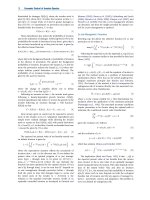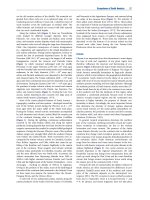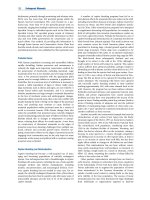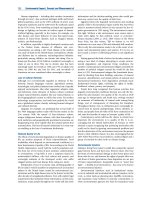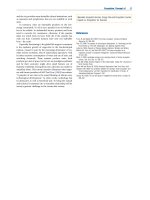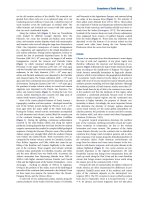Encyclopedia of biodiversity encyclopedia of biodiversity, (7 volume set) ( PDFDrive ) 1824
Bạn đang xem bản rút gọn của tài liệu. Xem và tải ngay bản đầy đủ của tài liệu tại đây (53.67 KB, 1 trang )
Energy Flow and Ecosystems
Analysis of guilds and that of functional groups are
different approaches used to study shifts in feeding behavior
and to complement trophic-level analysis. Guilds are defined
as assemblages of species or individual age classes that share a
common source of energy at any given time (e.g., nectarfeeding birds and bees and insect-feeding birds and spiders).
Functional groups are defined as being similar in their mode
of feeding (e.g., filter feeders, shredders, and pursuit predators), but individuals may use a variety of different sources as
resource availability shifts. Thus, individuals of a single species
may be distributed over several trophic levels and belong to
different guilds and functional groups during each individual’s
life span and reproductive period. As nutritional requirements
change and the availabilities of different types of food
resources also change, individuals can often adapt to find
different available sources of energy. Analyses of similarities in
these adaptations and the degree of overlapping functionality
are used to understand the degree to which producer and
consumer species are interdependent. Numerous complex
linkages (e.g., herbivory, predation, decomposition, parasitism, and mutualism) imply that few species are likely to be
complete substitutes for other species. As discussed later, some
species may interact positively, negatively, or neutrally in
association with other species. Such complex relationships
among species, especially under changing environmental
conditions, complicate field experiments and make predictive
models difficult to test fully.
Controls of Energy Flow in Food Webs
A small increase in species richness can have a large effect on
how energy flows through food webs. The main features are
the number of linkages among species and, especially, the type
and strength of those linkages (Paine, 1969). For example, a
simple trophic structure would be a linear series of three
species (A–C) in a food chain with one species in each trophic
level (Figure 2). Thus, a single species of plant is consumed by
a single species of herbivore, which is consumed by a single
predator species. Although analysis is relatively definitive in
these types of communities with few species, this simple food
chain structure may preclude consideration of some questions
A
A
B
B
C
C
of general concern, such as resiliency of the assemblage
following a disturbance and species loss.
If one more plant species is added (D) to a simple community, then this slightly more species-rich food web provides
some important additional dynamics in terms of alternative
pathways for energy to flow. Moreover, the herbivore (B) can
switch from one food resource to another and this additional
complexity increases generality and realism incrementally.
With two herbivore species (B and C) the food web is more
complex and the predator (A) has a choice of prey resources.
Even with the same number of species, much more realism is
added by considering the predator (A) to be an omnivore, and
even more is added if the predator and one of the herbivores
(C) are also cannibalistic. These simple diagrams show how
quickly the types and numbers of linkages (connectance)
within food webs can change the dynamics of energy flow
even with only a few species. This last example is typical of
some low-diversity stream food webs on isolated tropical
islands currently under study and discussed later.
Ecosystem Analysis
General rules regarding the relationships between energy flow
and the control of food web complexity are currently
incomplete. In some habitats a complex relationship apparently does exist among the total annual amount (and seasonal
distribution) of energy, the nutrient inputs to ecosystems,
and the number of different species in a habitat. In other
habitats there is no evidence for a cause-and-effect relationship among the rate of energy flow, species growth and
productivity, and the number of species in an ecosystem.
Other likely variables include evolutionary time and
biogeographical distributions as well as the frequency and
intensity of disturbances. The particular species composition
of a food web may also alter productivity. Empirical evidence
for predicting the importance of species-specific relationships
is increasing, but methods for establishing which species
regulate ecosystem functions remain controversial. Currently,
only a few studies have focused on the species-specific roles to
determine which species have unique roles and how these
roles shift as environmental conditions change.
A
A
D
241
B
C
D
E
B
D
C
E
Increasing trophic complexity
Figure 2 Energy flow through simple food chains and webs. Small increases in species number lead to high trophic complexity as connectance
(arrows) and cannibalism (looped arrows) increase. The number and strength of connections among species are more important in regulating the
flow of energy through food webs than simply the number of different species in food webs.
